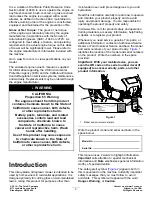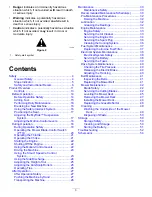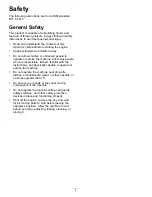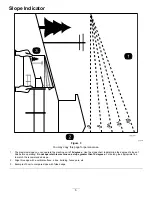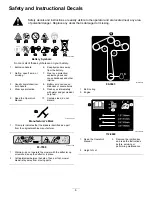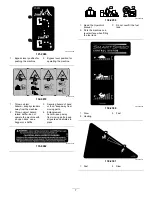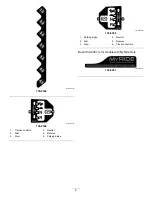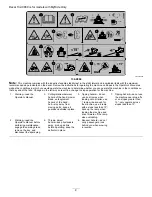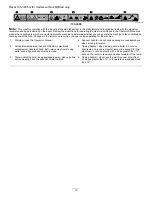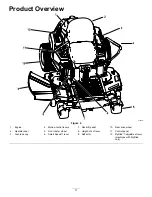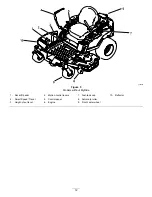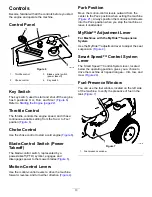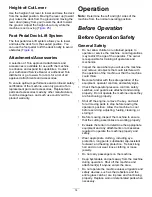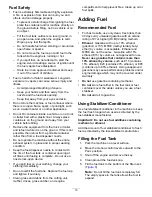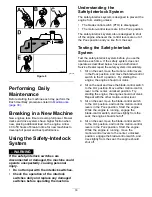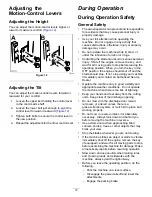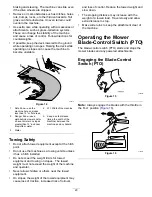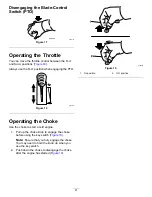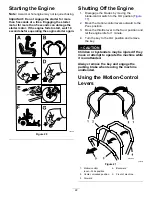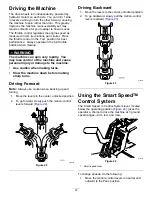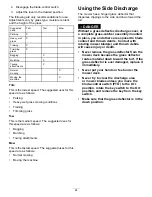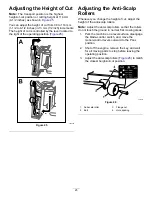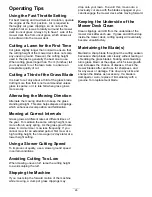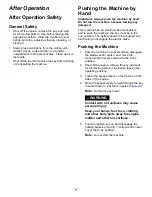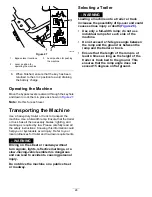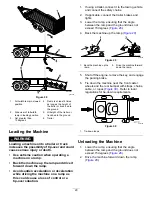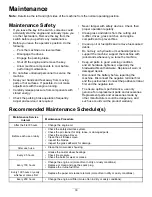
Fuel Safety
•
Fuel is extremely flammable and highly explosive.
A fire or explosion from fuel can burn you and
others and can damage property.
– To prevent a static charge from igniting the fuel,
place the container and/or machine directly on
the ground before filling, not in a vehicle or on
an object.
– Fill the fuel tank outdoors on level ground, in
an open area, and when the engine is cold.
Wipe up any fuel that spills.
– Do not handle fuel when smoking or around an
open flame or sparks.
– Do not remove the fuel cap or add fuel to the
tank while the engine is running or hot.
– If you spill fuel, do not attempt to start the
engine. Avoid creating a source of ignition until
the fuel vapors have dissipated.
– Store fuel in an approved container and keep
it out of the reach of children.
•
Fuel is harmful or fatal if swallowed. Long-term
exposure to vapors can cause serious injury and
illness.
– Avoid prolonged breathing of vapors.
– Keep your hands and face away from the
nozzle and the fuel-tank opening.
– Keep fuel away from your eyes and skin.
•
Do not store the machine or fuel container where
there is an open flame, spark, or pilot light, such
as on a water heater or on other appliances.
•
Do not fill containers inside a vehicle or on a truck
or trailer bed with a plastic liner. Always place
containers on the ground and away from your
vehicle before filling.
•
Remove the equipment from the truck or trailer
and refuel it while it is on the ground. If this is not
possible, then refuel from a portable container
rather than from a fuel-dispenser nozzle.
•
Do not operate the machine without the entire
exhaust system in place and in proper working
condition.
•
Keep the fuel-dispenser nozzle in contact with
the rim of the fuel tank or container opening at
all times until fueling is complete. Do not use a
nozzle lock-open device.
•
If you spill fuel on your clothing, change your
clothing immediately.
•
Do not overfill the fuel tank. Replace the fuel cap
and tighten it securely.
•
Clean grass and debris from the cutting unit,
muffler, drives, grass catcher, and engine
compartment to help prevent fires. Clean up oil or
fuel spills.
Adding Fuel
Recommended Fuel
•
For best results, use only clean, fresh (less than
30 days old), unleaded gasoline with an octane
rating of 87 or higher ((R+M)/2 rating method).
•
Ethanol
: Gasoline with up to 10% ethanol
(gasohol) or 15% MTBE (methyl tertiary butyl
ether) by volume is acceptable. Ethanol and
MTBE are not the same. Gasoline with 15%
ethanol (E15) by volume is not approved for use.
Never use gasoline that contains more than
10% ethanol by volume
, such as E15 (contains
15% ethanol), E20 (contains 20% ethanol), or E85
(contains up to 85% ethanol). Using unapproved
gasoline may cause performance problems and/or
engine damage which may not be covered under
warranty.
•
Do not
use gasoline containing methanol.
•
Do not
store fuel either in the fuel tank or fuel
containers over the winter unless you use a fuel
stabilizer.
•
Do not
add oil to gasoline.
Using Stabilizer/Conditioner
Use fuel stabilizer/conditioner in the machine to keep
the fuel fresh longer when used as directed by the
fuel-stabilizer manufacturer.
Important:
Do not use fuel additives containing
methanol or ethanol.
Add the amount of fuel stabilizer/conditioner to fresh
fuel as directed by the fuel-stabilizer manufacturer.
Filling the Fuel Tank
1.
Park the machine on a level surface.
2.
Move the motion-control levers outward to the
P
ARK
position.
3.
Shut off the engine and remove the key.
4.
Clean around the fuel-tank cap.
5.
Fill the fuel tank to the bottom of the filler neck
(
).
Note:
Do not fill the fuel tank completely full.
The empty space in the tank allows the fuel to
expand.
15
Summary of Contents for TimeCutter 5000C
Page 54: ...Schematics g307974 Electrical Diagram 139 2356 Rev A 54 ...
Page 55: ...Notes ...


